 |
||
|
||
| ||
Test results and analysesKeep in mind that a rendering time of different scenes on different accelerators is almost on the same level, that is why this test is not important as a video card doesn't affect a rendering time. However, the 3D MAX always had an error when rendering the third scene on the Radeon 8500 and Pentium 4.
 The driver of the FireGL2 didn't work either because:
 Scene 1A scene loading speed is almost the same on the
different accelerators with different drivers and on different platforms
- around 1 sec. However, the scene failed to load on the Quadro
2 MXR and Quadro 2 PRO, and the 3D MAX got an error at the end:

 This error occurred both under the OpenGL API and under the MAXTreme's driver. That is why an average fps for these cards in this scene is equated to 0. Below you can see how fast the animation works in this scene on different accelerators and APIs. The first mode is WireFrame, the window is of full size. It's quite easy to move objects, rotate the scene and its objects on all accelerators; the 3D MAX quickly reacts on changing of a mouse's position and redraws the window promptly. Now let's compare an average fps of the scene animated in this mode on different platforms and drivers:

 The Quadro DCC card thrives here; it is followed by the GeForce4 and then by the ATI FireGL2. Besides, the Intel turns out to be better, though it leads by a small margin.
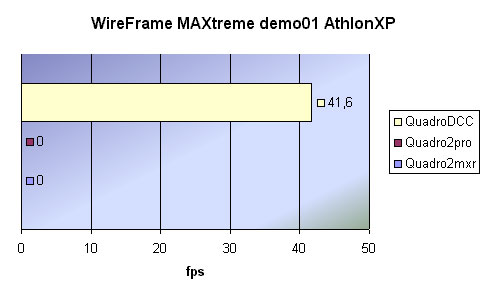
 Unfortunately, we were not able to compare three accelerators supported by the MAXTreme drivers as the scene couldn't be loaded on two of them; but it can be seen that the ELSA GLORIA DCC works faster with the MAXTreme drivers than under the OpenGL 1.3.0. Now let's look at the results when the scene is loaded in one of 4 viewport windows. It's comfortable to move and rotate objects on all accelerators, and all windows are rendered almost synchronously.

 The FireGL2 happens to be the best on the AMD's platform. Then we get the Quadro DCC card and the last among the three is the GeForce4. However, the Intel's platform turns out to be more beneficial. Under the MAXTreme driver:
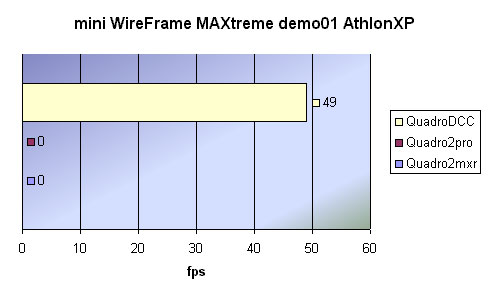
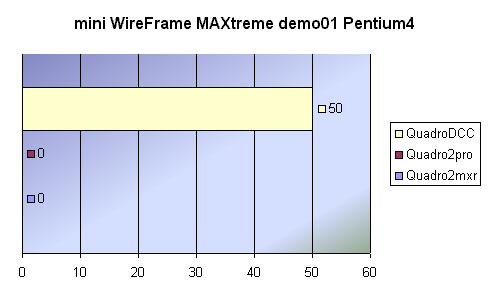 It's obvious that for simple scenes it is better to use special drivers, like in this case: MAXTreme for the Quadro based cards. And below are the results for the Facets mode:

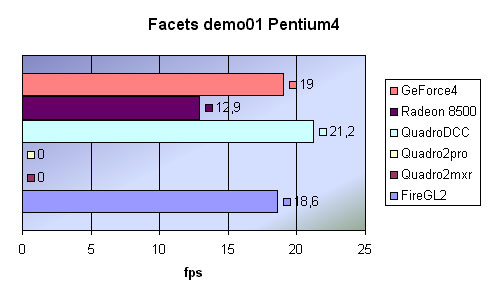 The three leaders are the same; the FireGL2 shows better scores this time on the AMD's platform; the leader is the Quadro DCC card again. Here are the results for the MAXTreme driver:
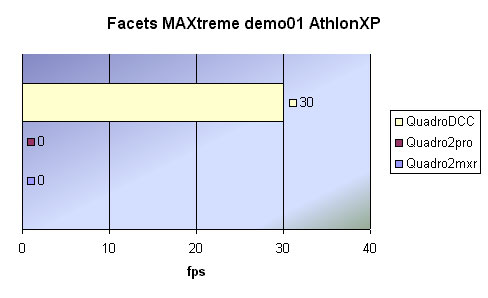
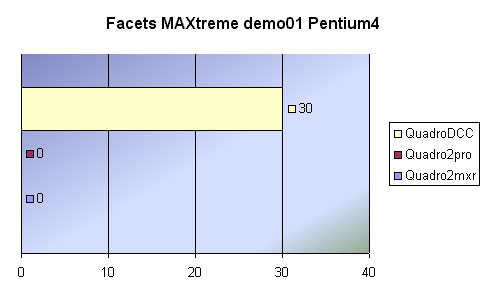 Small-window results:

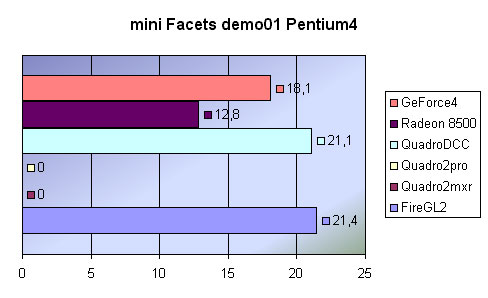 Under the MAXTreme:
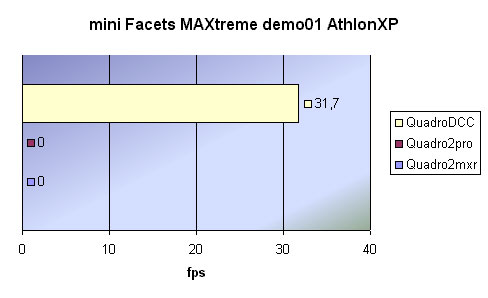
 This mode is tougher for the accelerators, and the average fps is lower now. The FireGL2 performs excellently in a small window. Below are the results for the Smooth+Highlights mode with the textures off in the full-size window:

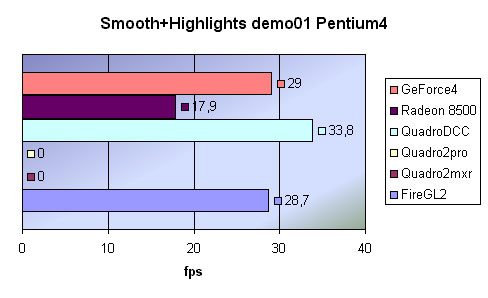 MAXTreme driver:

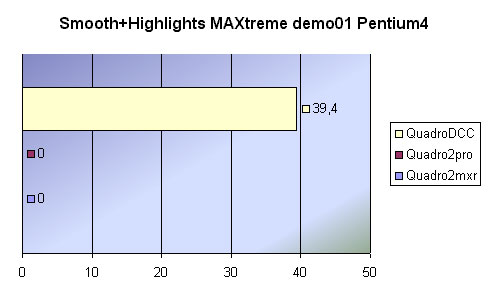 The leading Quadro DCC is followed by the GeForce4 and FireGL2. The scores on the Intel's platform are greater, though under the MAXTreme the Quadro DCC performs worse on this testbed (however, it might be just inaccuracy of measurements). Now the same mode for the small window:
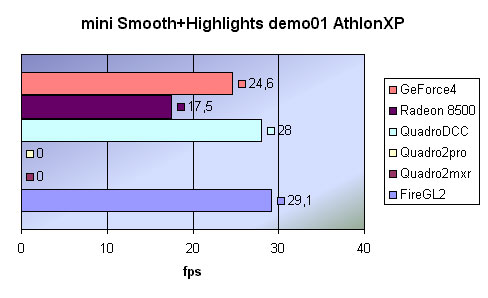
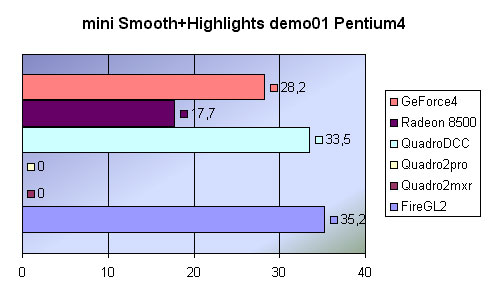 MAXTreme:

 The FireGL2 goes ahead, the Quadro DCC and GeForce4 are very close on the heels. On the Intel's platform the results are higher. And now the last mode for this scene: Smooth+Highlights with textures on, full-sized window.

 MAXTreme:

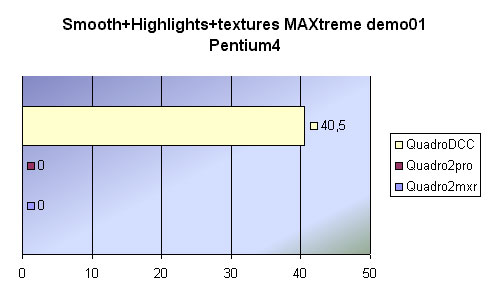 Mini window:
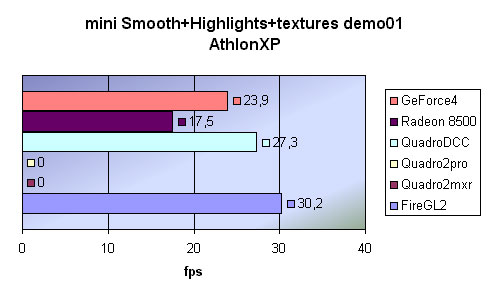
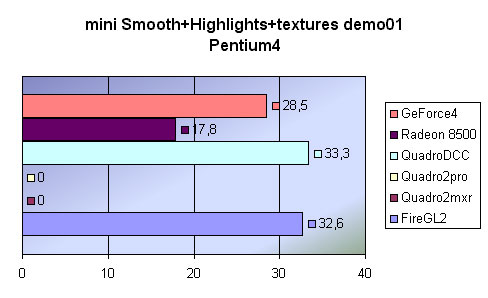 MAXTreme:

 The accelerators cope excellently with this mode although this one is more difficult than the previous one. The FireGL2 doesn't shine on the Intel's platform but renders the scene well in a mini window. On the whole, the Quadro DCC leads with confidence. In general, it's better to work on the Intel's platform in this scene, though the AMD's one doesn't fall behind much. Besides, the AthlonXP based system has a better price/performance ratio. As far as accelerators are concerned, the QuadroDCC turns out to be better, though it costs an arm and a leg. The GeForce4 is also a good purchase, especially if you play much. The FireGL2 has brilliant scores in small windows. On the contrary, the Radeon 8500 is a disappointing player today. [ Part 3 ] Write a comment below. No registration needed!
|
Platform · Video · Multimedia · Mobile · Other || About us & Privacy policy · Twitter · Facebook Copyright © Byrds Research & Publishing, Ltd., 1997–2011. All rights reserved. |